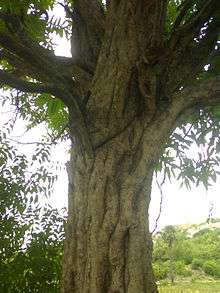Manilkara hexandra
| Khirni, Palu, Palai, or Rayan | |
|---|---|
 | |
| Scientific classification | |
| Kingdom: | Plantae |
| (unranked): | Angiosperms |
| (unranked): | Eudicots |
| (unranked): | Asterids |
| Order: | Ericales |
| Family: | Sapotaceae |
| Genus: | Manilkara |
| Species: | M. hexandra |
| Binomial name | |
| Manilkara hexandra (Roxb.) Dubard[1] | |
| Synonyms | |
Manilkara hexandra is a species in the tribe Sapoteae, in the Sapotaceae family that is native to much of south Asia (China: Hainan and southern Guangxi provinces; the Indian Subcontinent: Bangladesh, India, and Sri Lanka; Indo-China: Cambodia, Myanmar, Thailand and Vietnam.[1]
M. hexandra is a slow-growing evergreen tree that grows in tropical and temperate forests. It grows 40 to 80 feet tall and 1 to 3 meters in circumference. The bark is grayish black and rough. The wood is hard, heavy, and durable, weighing 70 pounds per cubic foot. The bark colour ranges from dark pink to dark purple. It is used for heavy structural work, gate posts, and big beams.[3]
It is used as rootstock for M. zapota, the latter being grafted on the former, and its fruit is edible.[1]
It is locally known as Khirni tree in Bangladesh and India.[4][5] In India, several regional names exist. In Tamizh it is called Ulakkaippaalai or Kanuppaalai.[6]
It is also called "Palu" (පලු) in Sinhalese or Palai and Rayan.[3]
References
- 1 2 3 4 Ann. Mus. Colon. Marseille ser. 3, 3:9, fig. 2. 1915 GRIN (March 17, 2008). "Manilkara hexandra information from NPGS/GRIN". Taxonomy for Plants. National Germplasm Resources Laboratory, Beltsville, Maryland: USDA, ARS, National Genetic Resources Program. Retrieved December 29, 2009.
- ↑ Pl. Coromandel 1:16, t. 15. 1795 GRIN (February 11, 2007). "Manilkara hexandra information from NPGS/GRIN". Taxonomy for Plants. National Germplasm Resources Laboratory, Beltsville, Maryland: USDA, ARS, National Genetic Resources Program. Retrieved December 29, 2009.
- 1 2 Forest Department (1962). Timber and its uses. Sri Lanka.
- ↑ "Socio-economic and horticultural potential of Khirni [Manilkara hexandra (Roxb.) Dubard]: a promising underutilized fruit species of India". Genetic Resources and Crop Evolution. 59: 1255–1265. doi:10.1007/s10722-012-9863-1.
- ↑ http://www.fruitipedia.com/khirni.htm
- ↑ "Manilkara hexandra (Roxb.) Dubard". India Biodiversity Portal. Retrieved 2016-11-03.
| Wikimedia Commons has media related to Manilkara hexandra. |